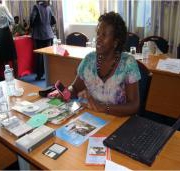Not Your Mother’s Telecenter
By now we’ve all heard of the telecenters of the 1990s – providing access to hardware and the internet, and shaping the face of ICT4D for a while. And while Internet Cafes are still prevalent, they no longer dominate the ICT4D discussion.

Photo Credit: WomenICTEnterprise.org
But there are still lessons that can be learned from past projects. The Kalomo Bwacha Women’s Club looks on the surface like any other telecenter, but in fact, it provided so much more than just access.
The enterprise provides email and telephone services; secretarial services; basic Internet training and browsing; and desktop publishing services such as the creation of calendars, brochures and cards using digital photography for government, public and private institutions, members of women’s clubs and individuals. The center engages women in using ICTs as part of an effort to transform the face of the district, socially and economically. Participants work to improve other women’s money making activities by using the internet to market their produce. The hope is that this approach will help foster economic growth in a place which is mainly dependent on farming and which has very few companies offering jobs to indigenous people.
There are ten core women members, only one of whom is paid, the rest working on a voluntary, part-time basis. The full-time employee works from 8.00am to 5.00pm, sees to the daily running of the club, types for the clients, operates the Internet, answers queries and so on.
The other members look for income-generating projects and recruit new members. They visit Kalomo villages, teaching and sensitising villagers, particularly women, on issues that affect them such as HIV/AIDS and poverty alleviation. They take digital photos, upload these onto their computers and make prints which they then use to distribute to other communities, sometimes in the form of a poster or a calendar with an educational message. They particularly promote women’s initiatives and highlight the plight of women in various communities. These visits help others to realise that they too can advertise their goods and services and learn from each other.
The club also generates income from affiliated clubs, which contribute a small annual fee. They distribute seed to their affiliated clubs who, once they have harvested it, pay them a fee. The seed may be maize seed, beans or any other that is expected to do well during that particular season. All this is at a concessional rate for the affiliated members. The club also holds community events to raise awareness and funds. The end of March will see an open market and a beauty competition, both organised by the club. ICTs play a major part in that participants will be encouraged to keep in touch via email and goods will be advertised on a web site, using digital photos. The club also hopes to create a database.
By sending women out, this “telecenter” reaches out into the community and makes changes in the lives of the women there. Rather than waiting for them to come to the center, the center brings its services and support to the community.
This is just one of several Women’s ICT-based enterprises described on the Women’s ICT Enterprise website. Although the site has not been updated in some time, the cases are still interesting and provide a good background for similar projects today.
Source: Comminit and WomenICTEnterprise





































